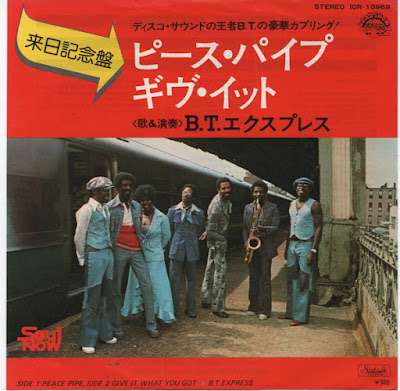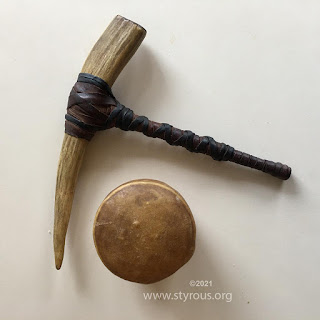Today is the birthday of Louis Thomas Hardin, aka
Moondog, born on May 26, 1916, he was an American musician, composer, theoretician, poet and, as was
Harry Partch, the inventor of
several musical instruments from odd parts. He was blind from the age of 16.
Although his music is symphonic, it ain't
Johann Strauss!
No frothy bon-bons here, however, there are touches of beauty and quiet
to be found in his works. His music has been performed by major orchestras all over the world and he has influenced many artists.
Hardin lived in
New York City
from the late 1940s until 1972, and during this time he could often be
found on 6th Avenue, between 52nd and 55th Streets, wearing a cloak and a
horned helmet sometimes
busking
or selling music, but often just standing silently on the sidewalk. He
was widely recognized as "the Viking of 6th Avenue" by thousands of
passersby and residents who were not aware of his musical career.
Born to an
Episcopalian family in
Marysville, Kansas, United States,
Hardin started playing a set of drums that he made from a cardboard box
at the age of five. His family relocated to Wyoming and his father
opened a trading post at
Fort Bridger. He attended school in a couple of small towns. At one point, his father took him to an
Arapaho Sun Dance where he sat on the lap of Chief Yellow Calf and played a
tom-tom made from buffalo skin.
Moondog is a gatefold album so that when it opens up, the front and back cover create a very large image . . .
Some of the segments are preceded by short
lines from his poetry. The opening,
Theme, is a bouncy delightful venture with staccato
strings, flute and what sounds like bongo drums (they aren't) followed
by brass which all build to a grand finale. This is followed by the ponderous
Stomping Grounds with
tympani doing most of the stomping.
Symphonique #3 (Ode To Venus) is one of those beauty spots I mentioned earlier. The violin duet opening is right out of a
Haydn music book. A delightful foray for strings, it is very lovely.
Symphonique #6 (Good For Goodie)
is a syncopated, jazzy and bouncy festival for reeds with trombone and
tuba backup followed by brass. It could very well have been written in
the heydays of Harlem.
Mini-Sym
#1 is almost a continuation of Goodie at the beginning but after a
minute or so, it settles into a fugue, slows down then starts up again
into a fast and syncopated rhythm. A little later in the work, Bird's Lament revisits it.
Although it is less than two minutes, Bird's Lament
is a tour de force with its fast pace that is a sweet reed heaven with a
syncopated and jazzy beat and a snare back up.
Witch Of Endor
is delightful! The first movement is almost danceable; the second is
mysterious with vibrato stings; the third is a plodding tune with oboe
and clarinet swirling around each other while the strings create the
drama then the whole orchestra joins in. The Finale is very slow and
dramtic at first then it goes into the original dance with oboe and
violin that are joined by bassoon then orchestra which all softly fade
out. I would have liked it to have a definite end but then, I'm not the
composer!
Tracklist:
Side 1:
A1 - Theme - 2:35
A2 - Stamping Ground - 2:36
A3 - Symphonique #3 (Ode To Venus) - 5:51
A4 - Symphonique #6 (Good For Goodie - 2:45
Mini-Sym #1 - (5:45)
Side 2:
B1a - I - Allegro
B1b - II - Andante Adagio
B1c - II - Vivace
B2 - Lament I, "Bird's Lament" - 1:42
Witch Of Endor (6:29)
B3a I - Dance
B3b II - Trio
B3b1 A. Adagio (The Prophesy)
B3b2 B. Andante (The Battle)
B3b3 C. Agitato (Soul's Death)
B3c III - Dance (Reprise)
B4 - Symphonique #1 (Portrait Of A Monarch) - 2:36
Companies, etc.
Manufactured By – Columbia Records
Produced For – Poseidon Productions (3)
Pressed By – Columbia Records Pressing Plant, Pitman
Printed By – Shorewood Packaging
Published By – Archimedes Music
Published By – Skiff Music Corp.
Mastered At – Customatrix
Credits:
Baritone Saxophone – Wally Kane
Bass – Alfred Brown, George Duvivier, Louis Hardin, Ron Carter
Bass Clarinet – Ernie Bright*
Bass Trombone – Paul Faulise
Bassoon – Don Macourt*, George Berg, Jack Knitzer, Joyce Kelly, Ryohei Nakagawa, Wally Kane
Cello – Charles McCracken, George Ricci
Clarinet – George Silfies, Jimmy Abato, Phil Bodner
Composed By [All Selections], Liner Notes – Louis Hardin
Contrabass – Joe Tekula
Design [Album Design] – Ron Coro
Engineer [Engineering] – Arthur Kendy, Fred Plaut
English Horn – Henry Shuman*, Irving Horowitz
Flugelhorn [Flügelhorn] – Joe Wilder
Flute – Andrew Lolya, Harold Bennett
French Horn – Brooks Tillotson, James Buffington*, Ray Alonge, Richard Berg (3)
Percussion – Bob Rosengarden*, Dave Carey*, Elayne Jones, Jack Jennings
Photography By [Cover] – Don Hunstein
Photography By [Inside] – Fred Lombardi
Piccolo Flute – Harold Jones (2), Hubert Laws
Producer – James William Guercio
Producer [Associate Producer For Poseidon Productions] – Alfred Brown
Tenor Vocals [Tenore] – Eugene Becker, Raoul Poliakin
Trombone [Tenor] – Buddy Morrow, Charles Small*, Tony Studd
Trumpet – Alan Dean, Joe Wilder, Mel Broiles*, Teddy Weiss
Trumpet [Bass] – Danny Repole
Tuba – Bill Stanley, Don Butterfield
Tuba [Tenor] – Bill Elton, Bill Stanley, John Swallow, Phil Giardina
Viola – David Schwartz, Emanuel Vardi, Eugene Becker, Raoul Poliakin
Violin – Aaron Rosand, Paul Gershman
Notes:
Original pressing on the grey 2-eye label. In Unipak gatefold cover.
There
was no specific promo pressing of this LP, but promotional copies of
this pressing were sent out with radio timing stickers on front or a
small sticker at bottom-left stating "For Demonstration Use Only Not For
Sale".
All copyrights are administered by Archimedes Music
(ASCAP), a Division of James William Guerico Enterprises, Inc., except
Theme (Archimedes Music/Skiff Music Corp. [ASCAP]).
Cover photo/inside photos: Columbia Records Photo Studio
Printed in U.S.A.
Barcode and Other Identifiers
Rights Society: ASCAP
Other (Library of Congress catalog card number): R72-750723
Matrix / Runout (Side A, stamped, variant 1): XSM150716-1A
Matrix / Runout (Side B, stamped, variant 1): XSM150717-1A
Matrix / Runout (Side A, stamped, variant 2): XSM150716-1B
Matrix / Runout (Side B, stamped, variant 2): XSM150717-1B
Matrix / Runout (Side A, stamped, variant 3): XSM150716-1A p o
Matrix / Runout (Side B, stamped, variant 3): XSM150717-1D p C3 o
Moondog (2) – Moondog
Label: Columbia Masterworks – MS 7335
Format: Vinyl, LP, Album, Gatefold - UNIPAK
Country: US
Released: 1969
Genre: Jazz, Classical
Style: Big Band, Contemporary
Viewfinder links:
Net links:
YouTube links:
Moondog ~
"The human race is going to die in 4/4 time."
~ Louis Thomas Hardin
Styrous® ~ Sunday, July 19, 2020


















































